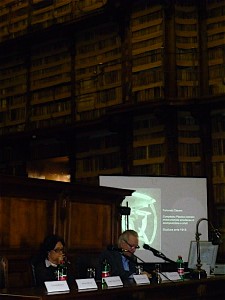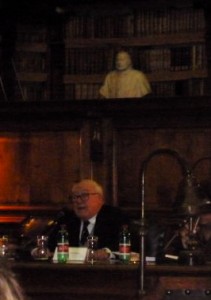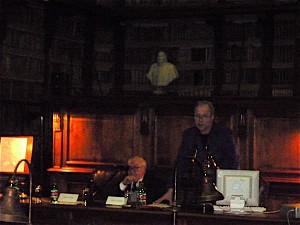…Una bellezza nuova…, a review by Selena Daly

A two day conference was held in Rome, in the Biblioteca Angelica near Piazza Navona, from the 15th to the 17th of January to mark the opening of the centenary year of the birth of Futurism. The conference took place in the library’s beautiful Salone Vanvitelliano, whose walls are lined floor to ceiling with three tiers of ancient books and parchments. One must wonder what the Futurists would have made of a conference in their honour being held in very kind of institution they longed to destroy and burn down. The conference, organised by the Ministero per i Beni e le Attività Culturali and La Sapienza University, which houses the Archivio del Novecento, boasted presentations from some of the most renowned scholars on Futurism, both in Italy and abroad. On the first afternoon, Marinetti’s eldest daughter, Vittoria offered a brief discussion of Luciano de Maria, while the Friday afternoon session offered the rare chance to hear Mario Verdone, the patriarch of Futurist studies, describe his first meeting with Marinetti in 1935 and his subsequent contact with the movement and its protagonists, first as a journalist and later as an academic. There were certain themes running through several of the presentations. One was a consideration of the origins of Futurism with papers presented on the movement’s relationship with Symbolism (Francesca Bernardini), and on Marinetti’s relationship with Lucini (Cristina Benussi) and with D’Annunzio (Gianni Eugenio Viola). Futurist ideology and political aspects were also tackled by several academics, among them Franceso Muzzioli and Mauro Canali.

Günther Berghaus offered a particularly engaging presentation on the role variety theatre and popular entertainment in the creation of a Futurist aesthetic. He explored the French revue performances, the English music halls and the German kabarets as influences on Marinetti’s formation of a theory of drama and on the Futurist sintesi. Attendees were also offered papers on Futurist journals (Umberto Carpi and Cecilia Bello Minciacchi) and Umberto Boccioni (Gino Agnese and Simonetta Lux). Matteo D’Ambrosio discussed the influence of Italian Futurism on the first Russian Futurist manifestos, during the years 1912 to 1915. While the influence of Italian Futurism on its Russian counterpart during the 1920s and 1930s is acknowledged, its influence on the period covered by D’Ambrosio’s paper is more difficult to ascertain.

Antonio Rava offered an interesting discussion of the use of new materials, such as celluloid and enamel, in Futurist artworks. On the evening of January 16th, the conference participants were offered the chance to see a “spettacolo vocale su testi futuristi” performed by the theatre group Duale. The performers recited extracts from Futurist manifestos and literary texts, experimenting with vocal range and intonation, as well as onomatopoeia and words-in-freedom. While the concept was excellent, performative aspects were somewhat lacking, though it must be noted that the piece was a work-in-progress. The performers stood with their backs to the audience and their text seemed more suited to a radio play than a live performance in front of an audience. Also, 60 minutes was probably rather too long for a performance of this nature. Overall, while the standard of the presentations itself was very high, the conference suffered from the failure to offer time for discussion after each paper or panel.
Selena Daly is a PhD candidate at University College Dublin, Ireland. Her thesis focuses on the literature and theatre of Italian Futurism. Her research is funded by the Irish Research Council for the Humanities and Social Sciences and by the National University of Ireland.
originally published 1/26/09